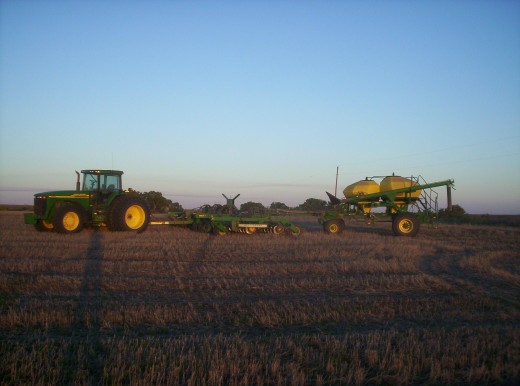
It rained yesterday and today which has stopped us from being in the fields. There are lots of work to be done in the fields right now, soybean harvest is under way, wheat seeding is also taking place, and corn is ready for harvest. Soybeans take priority because if they are not harvested when they are ready the pods that the seeds grow in will become brittle and the seeds will fall out on the ground causing a large field loss. Wheat also needs to be seeded in a timely manner so will produce adequate vegetation before it goes enters winter dormancy. Corn is a crop that can withstand more adverse weather with minimal field loss and quality deductions and we commonly wait to harvest it after wheat seeding is completed. In addition to this our grain sorghum will be ready to harvest after a killing frost and the late seeded sunflowers will be ready for harvest after the grain sorghum is harvested. The later sunflowers were seeded in feilds after wheat was harvested from them.
The early seeded sunflowers were harvested in the last part of September / early October and much of it is already seeded to wheat and the rest will be seeded to wheat when the land dries to allow proper seeding.

This is a photo of our air seeder, also known as a grain drill. The primary purpose of this tool is to seed wheat, but it can also be used to seed soybeans and grain sorghum. The photo at the top was taken looking through the tractor window while seeding wheat into residue from the previous wheat crop.
The tractor is in the front, pulling and powering the drill. We seed in 30 foot wide swaths placing seed and fertilizer in 0.50 inch rows 7.5 inches apart. The piece in the center does the seeding by cutting a slot into the soil, dropping seed and fertilizer in the slot, and closing the slot by pressing soil into the slot. Following the drill is an air cart that carries fertilizer in the front tank and seed in the rear tank. Seed and fertilizer is metered out and air carries it through tubes to the drill where the product is seeded into the soil. Only a portion of the fertilizer is applied now, with much of it being phosphuros with some nitrogen and zinc and sulfur if soil test recommend them. The rest of the fertilizer will be added in the spring as the crop starts regrowing and requiring it.

No comments:
Post a Comment